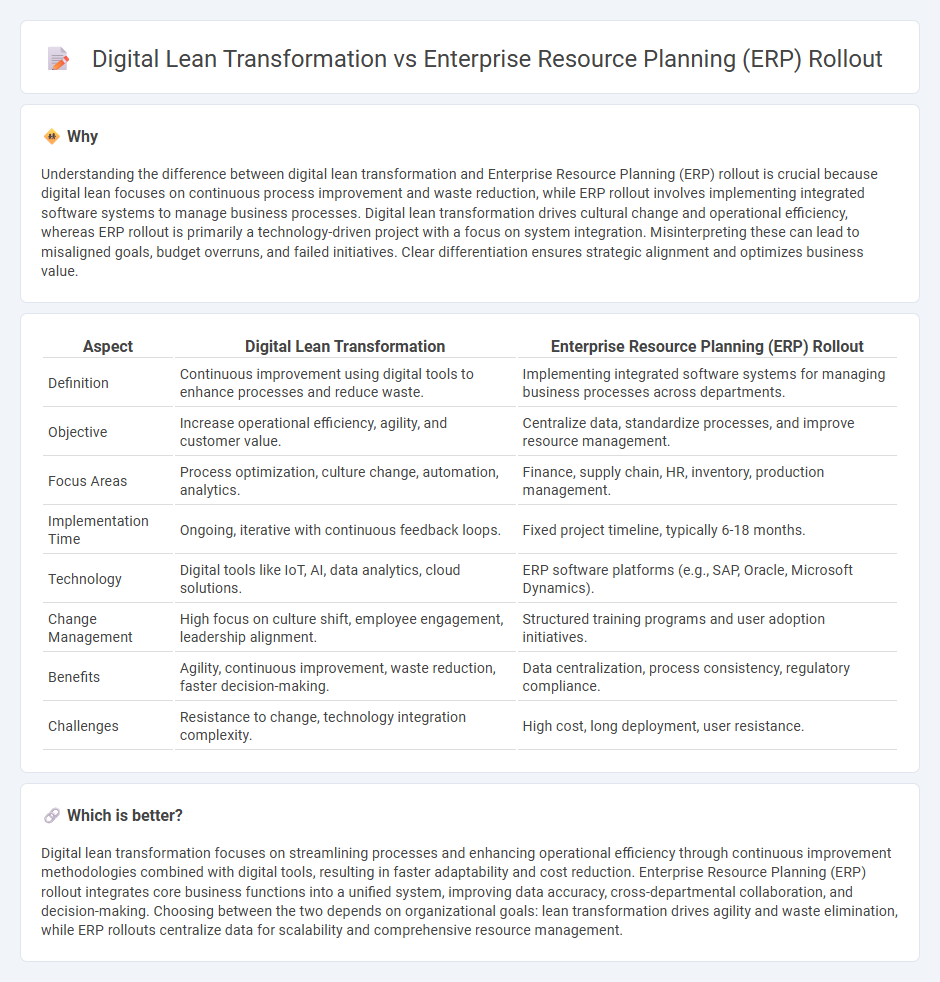
Digital lean transformation focuses on streamlining processes and eliminating waste through continuous improvement and technology integration, driving agility and efficiency across the organization. Enterprise Resource Planning (ERP) rollout involves implementing centralized software systems to manage core business functions and improve data accuracy and decision-making. Discover how these strategic approaches differ and complement each other to elevate business performance.
Why it is important
Understanding the difference between digital lean transformation and Enterprise Resource Planning (ERP) rollout is crucial because digital lean focuses on continuous process improvement and waste reduction, while ERP rollout involves implementing integrated software systems to manage business processes. Digital lean transformation drives cultural change and operational efficiency, whereas ERP rollout is primarily a technology-driven project with a focus on system integration. Misinterpreting these can lead to misaligned goals, budget overruns, and failed initiatives. Clear differentiation ensures strategic alignment and optimizes business value.
Comparison Table
| Aspect | Digital Lean Transformation | Enterprise Resource Planning (ERP) Rollout |
|---|---|---|
| Definition | Continuous improvement using digital tools to enhance processes and reduce waste. | Implementing integrated software systems for managing business processes across departments. |
| Objective | Increase operational efficiency, agility, and customer value. | Centralize data, standardize processes, and improve resource management. |
| Focus Areas | Process optimization, culture change, automation, analytics. | Finance, supply chain, HR, inventory, production management. |
| Implementation Time | Ongoing, iterative with continuous feedback loops. | Fixed project timeline, typically 6-18 months. |
| Technology | Digital tools like IoT, AI, data analytics, cloud solutions. | ERP software platforms (e.g., SAP, Oracle, Microsoft Dynamics). |
| Change Management | High focus on culture shift, employee engagement, leadership alignment. | Structured training programs and user adoption initiatives. |
| Benefits | Agility, continuous improvement, waste reduction, faster decision-making. | Data centralization, process consistency, regulatory compliance. |
| Challenges | Resistance to change, technology integration complexity. | High cost, long deployment, user resistance. |
Which is better?
Digital lean transformation focuses on streamlining processes and enhancing operational efficiency through continuous improvement methodologies combined with digital tools, resulting in faster adaptability and cost reduction. Enterprise Resource Planning (ERP) rollout integrates core business functions into a unified system, improving data accuracy, cross-departmental collaboration, and decision-making. Choosing between the two depends on organizational goals: lean transformation drives agility and waste elimination, while ERP rollouts centralize data for scalability and comprehensive resource management.
Connection
Digital lean transformation enhances organizational efficiency by integrating lean principles with advanced technologies, directly supporting the successful rollout of Enterprise Resource Planning (ERP) systems. ERP implementations leverage streamlined processes and real-time data enabled by digital lean practices to optimize resource management and reduce operational waste. Effective alignment of digital lean transformation with ERP rollout ensures seamless adoption, improved productivity, and sustainable competitive advantage.
Key Terms
Change Management
Enterprise resource planning (ERP) rollout streamlines organizational processes by integrating key functions into a unified system, significantly improving data accuracy and operational efficiency. Digital lean transformation focuses on optimizing and automating workflows through digital tools, emphasizing continuous improvement and waste reduction to enhance value delivery. Explore how effective change management strategies can align both approaches to drive successful organizational growth.
Process Reengineering
Enterprise resource planning (ERP) rollout concentrates on integrating core business processes into a unified software platform to enhance data accuracy and operational efficiency. Digital lean transformation emphasizes process reengineering by eliminating waste, streamlining workflows, and leveraging digital technologies for continuous improvement. Discover how combining ERP implementation with lean principles can drive comprehensive organizational excellence.
Technology Integration
ERP rollout emphasizes centralized technology integration for streamlined business processes, ensuring data consistency across departments. Digital lean transformation adopts a holistic approach, integrating advanced technologies with lean methodologies to enhance operational efficiency and agility. Discover how blending these strategies can optimize your organization's technology landscape for maximum impact.
Source and External Links
How to Implement Enterprise Resource Planning (ERP) - ERP rollout involves assessing current systems, establishing a project team, selecting software, and carefully deploying the solution to improve productivity and cost savings across business functions.
6 Key Phases of an ERP Implementation Plan - The ERP rollout typically follows six phases: discovery and planning, design, development, testing, deployment, and ongoing support, emphasizing careful project direction and stakeholder involvement for success.
ERP Implementation Process: 8 Steps to a Successful ... - Key steps in ERP rollout include data migration, user training, thorough testing, and validation before going live, ensuring software meets business needs and users are prepared.
 dowidth.com
dowidth.com